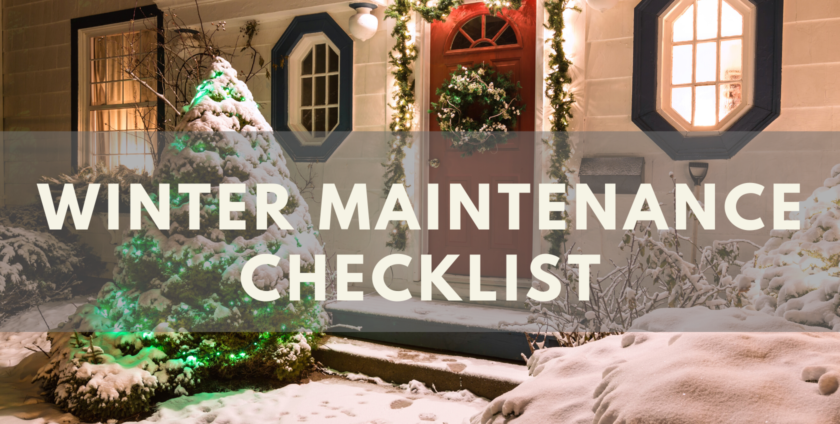
- December 12, 2019
Winter is coming! Actually, it’s already arrived.
To avoid costly repairs associated with harsh winter conditions, below we offer the 10 most important winter home maintenance tips.
1. Check Your Gutters and Drainage
Nothing worse than a clogged gutter! It can overflow and break, putting a strain on the roof itself. It can also fill with ice, which will cause thawing damage and strains the guttering. Well-maintained gutters can reduce the need to replace them, and the chance of roof damage, so do yourself a favor and keep those gutters clean and clear.
2. Test Your Sump Pump
Sump pumps act as the last line of defense against condensation buildup, floods, and water from drains. So test it to make sure it works; otherwise, you could end up with a flooded basement and foundation damage.
3. Check Your Window Wells
Don’t put your basement in danger–this is the time of the year where the liner failure in window wells is at its worst.
If your liner becomes detached from the foundation wall, soil pressure can widen the gap between the loose liner and the wall. This gives water an opportunity to penetrate when the soil becomes over-saturated. Inspect the liner and replace any that have become loose.
4. Clean Your Dryer Vents
As the colder months set in, your dryer is likely to get more use. Dyers can be a fire hazard, causing over 15,000 fires each year, so it is important to reduce this risk.
Make sure to remove the build-up lint from the dryer in order to reduce the fire risk and improve your household energy efficiency.
5. Check Your Electrical System
With the winter months bringing cold weather and days that stay dark for a longer time, the last thing you want is your electrical system to fail so be sure to schedule an electrical maintenance tune-up with a qualified professional.
6. Bleed Your Radiators
Your radiators will need bleeding each winter to ensure they run at full capacity and efficiency.
7. Avoid Ice Dams
In freezing conditions, ice dams can form at the edge of your roof. They prevent melting snow from draining properly. The water can leak into your roof and cause damage to ceilings, insulation, and walls.
To prevent ice dams from forming, keep the entire roof at the same temperature. To do this, increase ventilation and add insulation. Make sure to seal off every possible air leak that might warm the underside of the roof.
8. Seal Leaky Doors and Windows
Check your windows and doors by opening and closing them. When you close the lock, do you notice a gap between the seals? Leaky doors and windows can be simply filled with exterior latex caulk.
9. Weatherproof Exterior Pipes
Frozen pipes can crack, and once they thaw they can release hundreds of gallons of water in a single day. This can lead to serious structural damage.
Check all of your pipes for signs of weakness. And moisture on faucets and connectors can point to wear and tear. If there is moisture, replace these parts immediately.
Turn off your external pipes at the mains, and make sure they’re fully drained. It may be useful to double-check a few days later to ensure that all the water has fully drained.
For extra protection, you can also buy insulating tape to wrap around any exterior pipes and any other pipes that are found in the basement.
If you don’t have your plumbing plans at hand, it may be useful to paint your exterior faucet handles a bright color. This will make them easier to spot against snow or at night. It also means that a plumber can find the faucet for a faster repair if there’s an emergency in winter.
10. Prepare for Winter Storms
Winter brings freezing rain, sleet, and blizzards. Get prepared ahead of time so that the next big storm doesn’t leave you in trouble.
If you have a generator, you want to make sure that it’s working. Also, keep a stash of batteries for lanterns and flashlights in case of power outages and blackouts.
Another good tip is to keep a solar-powered or battery-operated radio in your home. This means that if cellphone reception goes out, you can keep up to date with the news and weather.
Check the condition of your snow shovels, gloves, and window scrapers. Store any heavy snow supplies near the door when you can get quick access to them.
Finally, a buildup of heavy snow on a tree limb can increase the risk of them breaking off. This poses a threat of injury to people and property damage.
Also, brush snow off tree limbs after each big snowfall. You can use a broom to extend your reach.
Your Essential Winter Home Maintenance Guide
As you can see, there are plenty of things you can do when performing winter home maintenance to protect yourself from a harsh winter. By weatherproofing, checking your home, and performing preventative maintenance, you can ensure that the cold and wet stays outside.
Source: happyhiller.com
Leave a Reply

